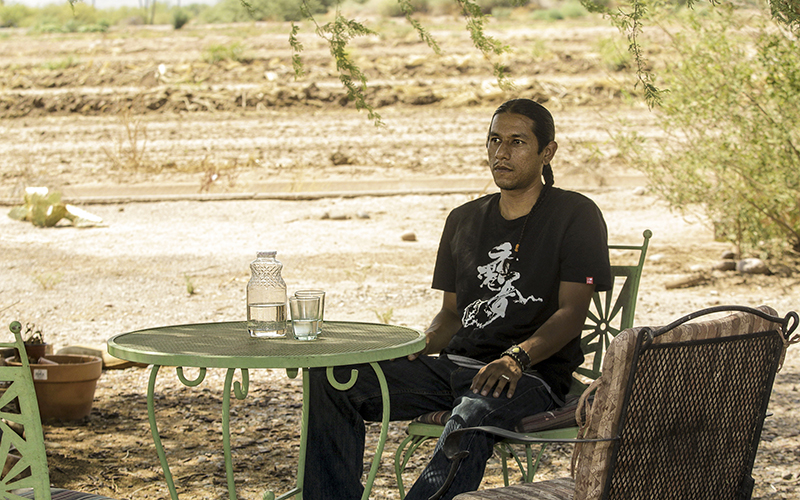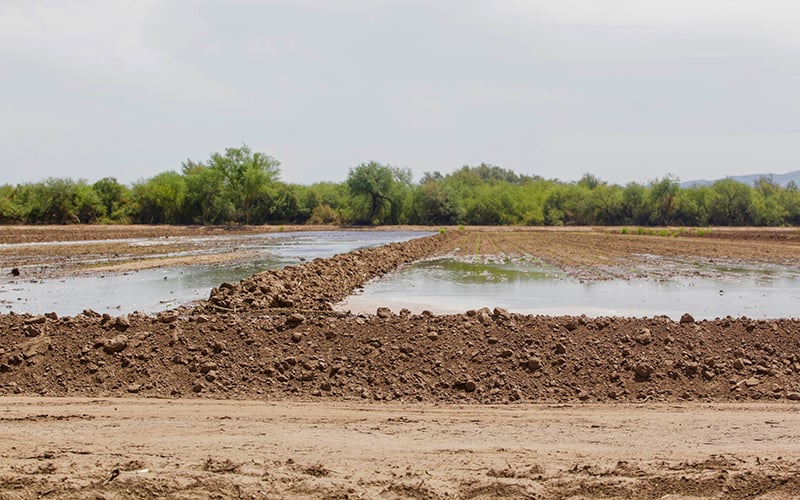
Pii Paash member Reuben Cruz says his people’s environmental concerns are not being taken into account as the Gila River Indian Community prepares to trade Colorado River water for reclaimed water to irrigate fields. (Photo by Isabel Menzel/Cronkite News)
LAVEEN – A deal to trade Colorado River water for reclaimed water to irrigate fields on the Gila River Indian Community has been the source of a months-long battle between the Pii Paash people and the larger Gila River community.
Concerned for potential health risks for themselves and the surrounding wildlife, the Pii Paash voted on Sept. 19, 2015 to keep reclaimed water out of its territory. However, the Gila River Indian Community (GRIC) Tribal Government made a deal to install West Side Laterals Pipelines and trade Central Arizona Project water for reclaimed water from Chandler and Mesa municipalities. Reclaimed water is often used for irrigation to save water resources. GRIC saves money and water by making the trade, officials said.
During a meeting in June, the GRIC approved moving reclaimed water to an area that adjoins the Pii Paash land, but the group of about 1,000 remains worried that the water will seep onto its land and believes the environmental questions have not been answered.

Pii Paash land on the Gila River Indian Community needs water for irrigation, but they do not want the reclaimed water the community is getting in a trade for Colorado River water. (Photo by Isabel Menzel/Cronkite News)
“We have a hard time understanding our tribal government’s position,” Pii Paash member Reuben Cruz said. “They’re supposed to work toward the benefit of the health and welfare of the community, but we have all these questions left unanswered.”
According to June Shorthair, the Gila River Indian Reservation’s public affairs officer, this exchange will reduce the Community’s overall irrigation costs, as the community’s primary goal is to increase agricultural development. The water that will be delivered to GRIC districts will be highly treated Class A+ quality, Shorthair said.
“We are not aware of any increased risks using Class A+ reclaimed water for irrigation over any other water source that is used for irrigation,” Shorthair said.
According to the National Center of Biotechnology Information, Arizona is the only state in which water reuse is regulated by a laboratory certification program and also checks for the concentration of enteric viruses and giardia in reclaimed water. But studies have shown that high concentrations of salt or salt ions in reclaimed water can be damaging to wildlife and plants.
Cruz said that water treatment plants test for only dozens of the 10,000 contaminants, and when they have contacted the the Environmental Protection Agency, they don’t present enough science and only discuss the benefits of using reclaimed water. He worries that it might be to blame for outbreaks like salmonella.
“We want to know what kind of effects these pathogens in the water will have on plants and animals,” Cruz said. “To us, they tell us specifically that we cannot drink it or bathe in it. But what about the animals that we eat? Toxins can become more concentrated when they are consumed in an animal first.”
The Pii Paash have strong connections to the water and are known as river people. Cruz said his people know that they can dig 10 feet and hit the water table. When water is used for irrigation purposes, it won’t filter through rocks and gravel, but instead it would be the of mixing reclaimed water with groundwater.
“When I see how small of a nation we are and how many toxins flow into our territory, I feel we are an endangered species,” Cruz said. “People use terms like environmental racism. It’s cost effective to use this abundant land, but it is pristine to us and we understand the dynamics of the watershed.”
Cruz and other Pii Paash felt their small community was overshadowed by GRTC’s wishes.
“Here in the tribe we’ve mentioned it to our council,” Pii Paash elder Joe Biakeddy said. “Our complete district signed petitions saying that we don’t want this, but it’s at the point where it’s being forced upon us.”

Pii Paash elder Joe Biakeddy said the Pii Paash signed a petititon to keep reclaimed water off of its portion of the Gila River Indian Community. (Photo by Isabel Menzel/Cronkite News)
“The whole reservation’s population is 20,000, and their say doesn’t illustrate the impact this could have on our small population,” Cruz said. “The larger population trumps the needs of a smaller community, which happens all the time with indigenous people.”
Shorthair said CAP water is very expensive because of transportation costs for moving it from Lake Havasu.
“The Gila River Indian Community has an annual entitlement of 311,800 acre-feet of CAP water, which is Colorado River water that is pumped out of the river in Lake Havasu and transported to the central Arizona via the CAP delivery system,” Shorthair said. “The Community received its CAP water through a water settlement as “in-lieu” water to replace and supplement some of its water rights to the Gila River.”
Cruz worries about whether the water will be safe for fragile species. When he questioned the EPA about wildlife in a recent meeting, their responses were “they’re animals and they can take it, they’re stronger than us,” Cruz said.
“They shy away from our questions but then they put up signs to stay out and ‘do not drink.’ That’s fine for humans, but what about the animals?” Cruz said. “What about the fragile animals like the small birds in our songs and stories? Can the hummingbird’s body withstand those toxins? They don’t know this is harmful, they just go to the water in the desert.”
However, the Arizona Department of Environmental Quality encourages the use of reclaimed water as a solution for water conservation in a state plagued by drought. They said that in 2001, A+ reclaimed water was established for its end uses and it is suitable for irrigation, food crops and livestock watering.
Shorthair said Arizona has been a leader in re-using its wastewater to improve water conservation.
“More than 80 percent is recycled – from irrigating golf courses to replenishing the water table,” Shorthair said.
Correction: A previous version of this story incorrectly characterized the type of water the Gila River Indian Community was trading for reclaimed water. The GRIC is trading Central Arizona Project water from the Colorado River.
In addition, a previous version incorrectly stated that salt ions in reclaimed water can spread disease. Heavy concentration of salt in reclaimed water can be damaging to wildlife and plants, studies have shown.